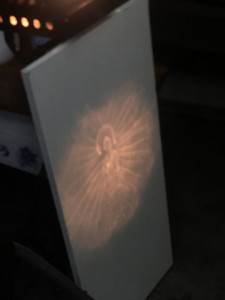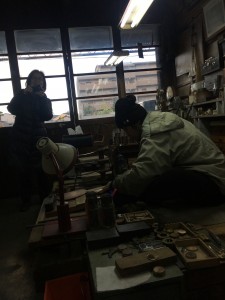Today was pretty packed. We started off with a lecture by Professor Pellechia, a short lunch, a lecture by Professor Ludvik, and finally a studio visit with Master Mirror Maker, Yamamoto-san.
Since Noh is the topic on which I will be presenting at the end of the visit, I already knew a good amount of what was included in the lecture; however, he ended up filling a lot of gaps that I had not come across in my research, so it was very informative; we also analyzed a play, Haku Rakuten. Within what I had read about Noh, and perhaps this is even the case with all the traditional arts, I had gotten the impression that it was an incredibly rigid practice, in many senses of the words. Though they are using the same stage implements, costumes, masks, and plays, there is room for interpretation and stylistic choices. In the exact same way that Miyamoto-san puts his own signature on Buddhist sculpting, Noh schools perform the same plays in their own way. I think this point is especially important when thinking about the concept of ichi-go ichi-e. The creation, and viewing of these plays, is a once in a lifetime experience. Even when accounting for the schools’ differences, you are still left with a completely unique experience. Previously, my concept of creativity was this general idea that an artist would create these very individualistic works in terms of form and composition, and then leave it in a gallery–and that was it: creativity. This definitely reads as Western-centric thinking, too me. After hearing the lecture, I left with the feeling that this idea was not not necessarily more creative at all. Despite adhering to similar forms, the unrehearsed nature of the performance gives it this “real” feeling that Prof. Pellechia talked about. And in that vein, it also got me thinking about how different shite can connect to character’s differently. Though the school informs their style, the actors must commune and connect with the character completely; and because people live different lives, they find different avenues. This crystallized, in my head, during Prof. Ludvik’s lecture on Nehan painting. When we looked at Itō Jakuchū’s Yasai Nehan, she talked about how many artist personalized the nehan scene, and that it was okay because it was about people’s individual connections to Buddhism and life. In Itō Jakuchū’s case, he was responding to the death of his brother and family’s business; similarly, a Noh actor recently suffering similar news, or maybe even getting amazing news, will make them interpret and feel the character in completely different ways. I am still uncertain if this thinking of mine aligns with that of actual shite’s, so I am excited to pose some of these questions and concerns, when we meet with Udaka-san.
Our last stop was at Yamamoto-san’s studio. The first thing that struck me was his work space. It was in no way pretentious, despite the fact that he is the only maker of makyo mirrors. That is another thing that has been consistent on this trip. Many of these artists are simply passionate about the history and practice of their work, and using that work to connect to people: in the past, presently, and in the future. I cannot imagine it is ideal to have eight random people bumbling around your relatively packed space, so it was really kind of him to let us use his tools and show us how he works.

Yamamoto-san showing how makyo mirrors work

the reflection of light from a makyo mirror

Yamamoto-san showing us the process of filing
